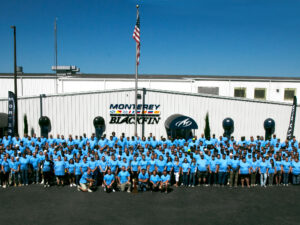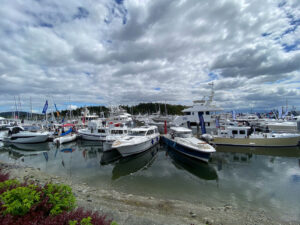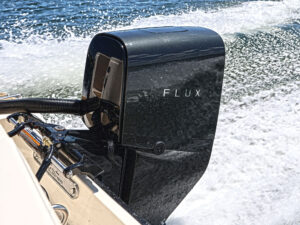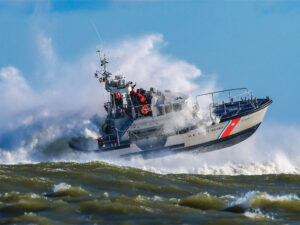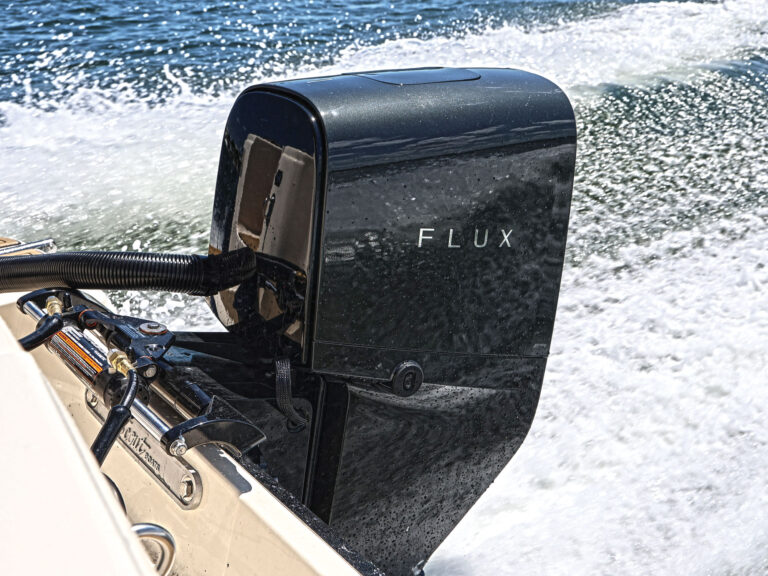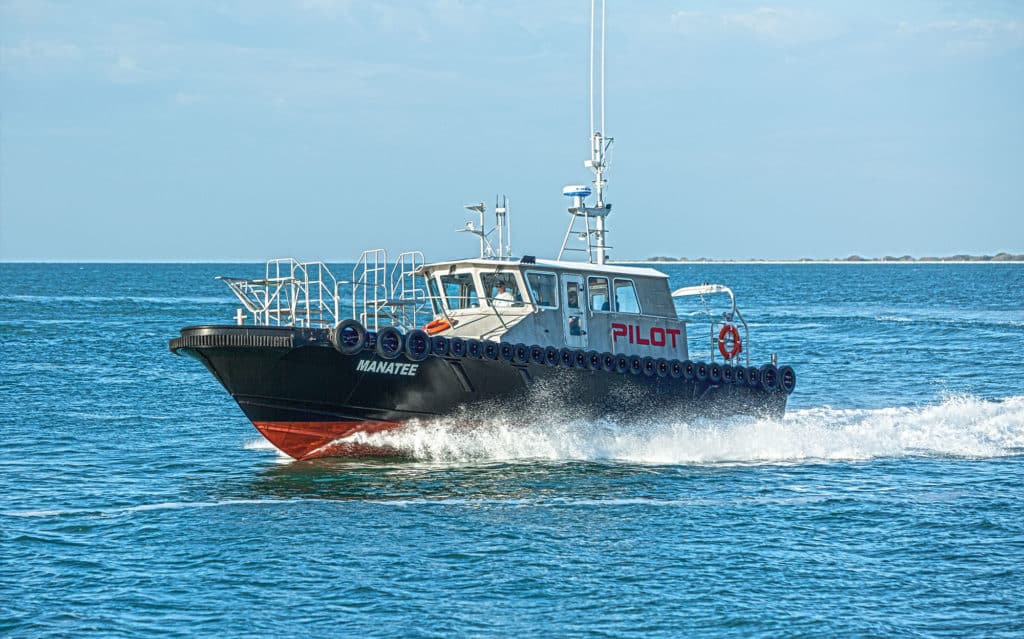
It’s still dark at 5:30 a.m. when we board Manatee at Fort De Soto State Park on the outside edge of Florida’s Tampa Bay. As I track the 53-foot-6-inch pilot boat on my smartphone’s Vessel Traffic app, veteran boatman (launch captain) Steve Jean idles us away from the dock at 2.9 mph. A glance at a sound meter shows the noise level from the boat’s twin 503 hp Volvo Penta D11 diesels at a whisper-quiet 60 decibels. Seated next to me in one of the pilothouse’s comfortable Stidd shock-absorbing chairs is Pilot Capt. Joe Lachnicht. We chat for a couple of minutes about the Tampa Bay Pilots Association before I glance at the phone again.
This time, our speed is at 27 mph, with sound at a quiet 65 dBA. Wait a minute, when did Capt. Jean push the throttles? I never felt — or heard — the 52,000-pound aluminum boat accelerate. As Jean takes us out past Egmont Key toward the sea buoy, Manatee cleaves through the 2-foot seas as if they weren’t there.
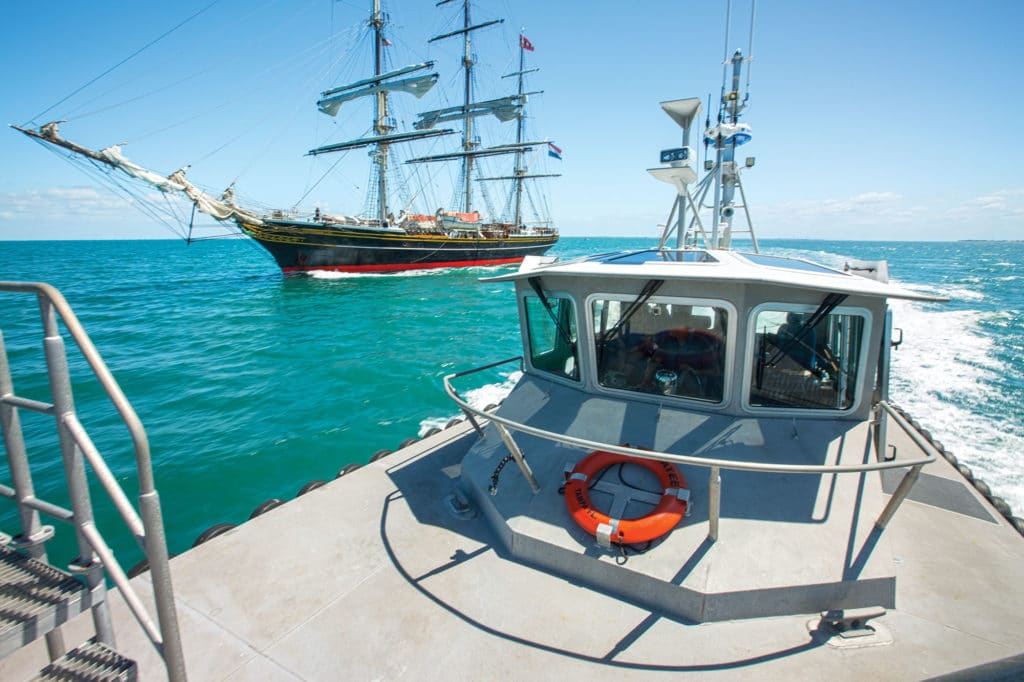
Several miles out, we meet Regula, a 430-foot Cyprus-flagged container ship coming into the Port of Tampa from Tuxpan, Mexico, at 11.5 mph. Jean slides Manatee along the ship’s lee side (starboard in this case), keeping pace with it to plant our boat’s port bow firmly against the looming hull at a 5-degree angle as two crew members on the ship’s deck above lower a flexible Jacob’s ladder. Capt. Lachnicht, who has donned a life jacket and shouldered his briefcase, walks out onto Manatee’s open-bow deck, climbs three stairs up onto a boarding platform with a railing, and steps across onto the ladder, holding firmly to its sides. From there, he climbs 25 feet straight up to Regula’s still-moving deck to assume navigational command for the trip through Tampa Bay’s narrow ship channels to the port. Jean expertly turns Manatee away with a twist of the helm and a burst of the throttles. The supercharged and turbocharged D11s supply instant torque to the four counter-rotating propellers on the boat’s two forward-facing, articulating IPS2 drives (one three-blade and one four-blade propeller on each), which firmly bite into the disturbed water and cleanly carry us away.
Pilots, as their mission statements declare, “are charged with the safe navigation of vessels and the protection of life, property and the marine environment on the waters of the harbors where they are based.” Channels in most ports are narrow, dredged deep enough but offering only tight margins of safety from grounding, and traffic flow on tight schedules can be intense. Federal and state laws require all major shipping to employ skilled, licensed local pilots with up-to-the-minute knowledge of potential navigation challenges, which means these men and women must be ready to board or leave ships at all hours, year-round (with certain obvious exceptions, such as iced-in winters on Lake Superior), and the boatmen must be skillful and savvy enough to provide them safe transfers. So, what can the 56 member groups in the American Pilots Association do to minimize the hazards? By spending the day aboard Manatee, we aim to find out.
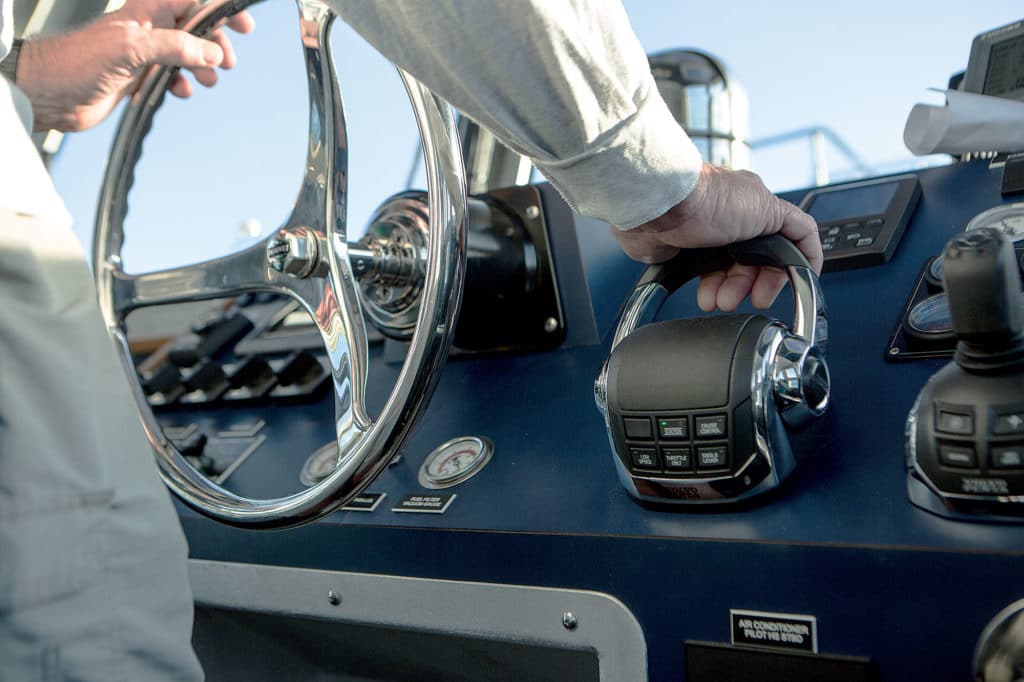
ShipShape
So what makes a great pilot boat? While several general characteristics for pilot boats exist, the specific environments under which the pilots operate vary greatly from port to port. The needs vary, from seaworthiness and speed, to deck layouts, lighting, interior accommodations and rescue equipment.
To start, we talked with the people who created Manatee and her sisters: designer Winn Willard from C. Raymond Hunt Associates in New Bedford, Massachusetts; builder Peter Duclos of Gladding-Hearn Shipbuilding in Somerset, Massachusetts; and Dave Brown and Jens Bering of Volvo Penta North America in Chesapeake, Virginia, who supplied the D11s and the IPS2 drives via distributor Power Products. Two points stand out from those conversations. First, even though Hunt Associates and Gladding-Hearn have been collaborating for many years, they ask questions and listen carefully to each pilots association’s needs on each new boat. The investment for each vessel is around $2 million, but more important, the pilots (and boatmen) in each port develop strong, experience-based opinions on what characteristics work on their home waters.
Certain basics hold for a number of harbors around the United States, so Hunt Associates and Gladding-Hearn have developed standard-size classes of pilot boats. Tampa Bay’s needs fall within the Chesapeake Class. Most of the boats built to date have straight-shaft inboard power. Manatee is the first with IPS pod drives and so is classified as a Chesapeake Mark II. The need here is to shuttle 4 to 8 nautical miles to pick up and drop off pilots between the dock at Fort De Soto State Park and the pilot station on Egmont Key — an island at the mouth of Tampa Bay — and the Egmont Key Channel buoy. For distances like these, Manatee’s cruising speed of 23 to 26 mph works.
The next requirement is seaworthiness. These are shallow, exposed waters that can throw up nasty, steep, tightly spaced seas. The designers must blend an able hull shape with the human accommodation needs for the Tampa Bay pilots. In this case, the latter is simple. The Egmont Key station offers shore facilities for meals and naps between ships, so Manatee’s accommodations include a head and one bunk, but the priority is the pilothouse, with five Stidd chairs to keep crew comfortable and one to minimize fatigue for the boatman. Another factor is sound, especially in a diesel-powered aluminum boat. As noted, Manatee’s pilothouse is seriously quiet, thanks to several engineering factors. More on this later.
Hunt Associates designs each Chesapeake Class boat with a wide, delta-shaped, sharply formed water plane (the two-dimensional horizontal shape at the waterline) with a fine point that works with the deadrise to split oncoming seas. Chine flats in the water in the aft half of the hull provide full-time stability and lift at planing speed. The relatively small pilothouse places the hull’s center of gravity low to keep it planted firmly.
Because of the rough-water challenges pilot boats face, rugged construction is a must. The resulting weight makes the ride more comfortable, though there is an upper limit to this effect, beyond which speed and efficiency suffer. Over the years, Hunt Associates has developed a broad portfolio of hulls for many applications and so has also learned to balance these factors for expected uses.
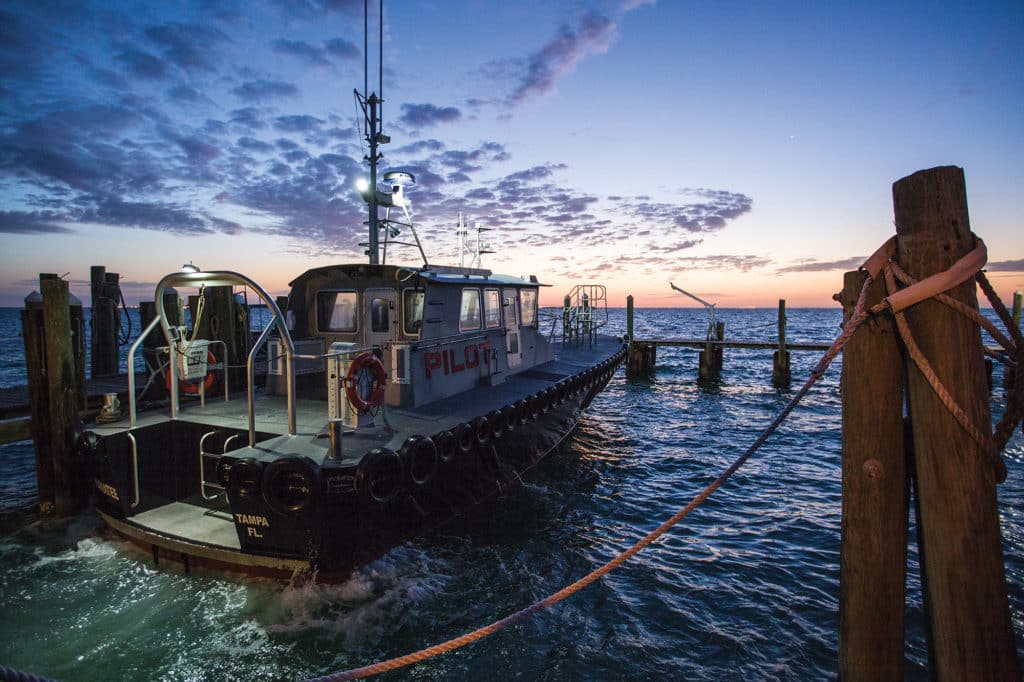
The bottom deadrise is constant at any crosswise station (location) in the hull, but it twists from 20 degrees at the transom to 30 degrees under the helm, and then a sharp 55 degrees at the bow (made possible because room for sleeping accommodations in the bow is not required). The bow is flared, with a softly rounded forefoot to knock down spray and provide reserve buoyancy for truly large seas while minimizing any tendency to bow-steer. A pair of carefully shaped and sized lifting strakes on each side of the bottom “peel water off the bow” to further minimize spray and drag, as Willard put it. The parallel thrust of the IPS drives on this bottom shape makes it run slightly bow-proud, at 2 to 4 degrees fore and aft. The boatman can dial in the trim to fit existing conditions with Volvo’s vertical interceptors fitted on the boat’s transom. They provide stern lift when extended downward and are much more durable than conventional trim tabs.
Meanwhile, the compact engine-IPS package fits easily under the boat’s afterdeck, providing great access for all maintenance and isolating the engines for sound dampening. Manatee’s pilothouse is located several inches farther aft than other Chesapeake Class boats with conventional inboard shaft drives, so its placement eases the ride for its occupants, reducing the fatigue factor of long days on rough open water. “It helps,” says Willard, “to have those drive units each mounted on a big rubber doughnut, with the engines seated on soft rubber mounts.” Lead and foam insulation around the engine room damp out low-frequency sound, with perforated sheeting insulation catching high-frequency vibrations.
Volvo Penta supplies the fully integrated power package. “The laws of physics apply even to Swedes,” says Bering with a chuckle. “The transfer of energy from diesel crankshaft to IPS propellers requires robust engineering. It’s all about converting that fuel into shove, a long train of engineering starting with the engine and continuing through the entire drivetrain. We use modern digital tools in our designs. We are both propulsion experts and naval architects.”
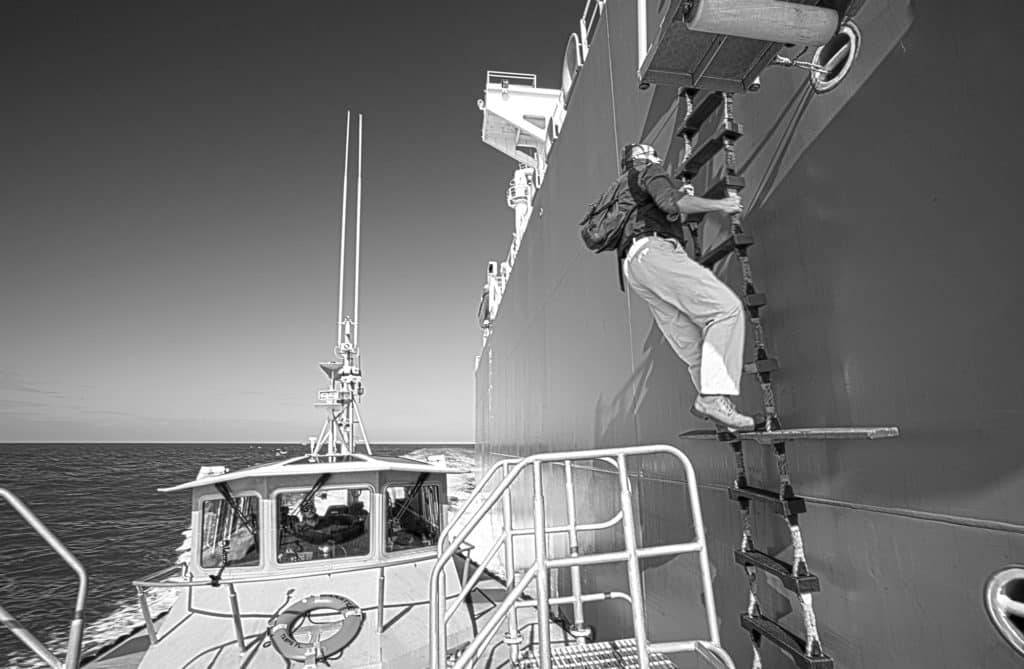
Strength of Purpose
No matter how good a design might be, the boat’s performance will also be dependent on how faithfully the boatyard reproduces that shape. Balancing everything, from engines to pod drives and batteries to pilothouse, is, Duclos says, “an accounting task. We set the fuel tank on the center of gravity, so the boat’s trim doesn’t vary with how full or empty it is.”
Volvo Penta also specifies special reinforcement in the bottom around the IPS drives. “IPS is a powerful rudder,” Duclos remarks. “We tweak the hull shape by adding a little chine beam to balance that force, then use three-dimensional finite element analysis [FEA] that applies stressors to see what happens in hypothetical crisis situations, like grounding at high speed.
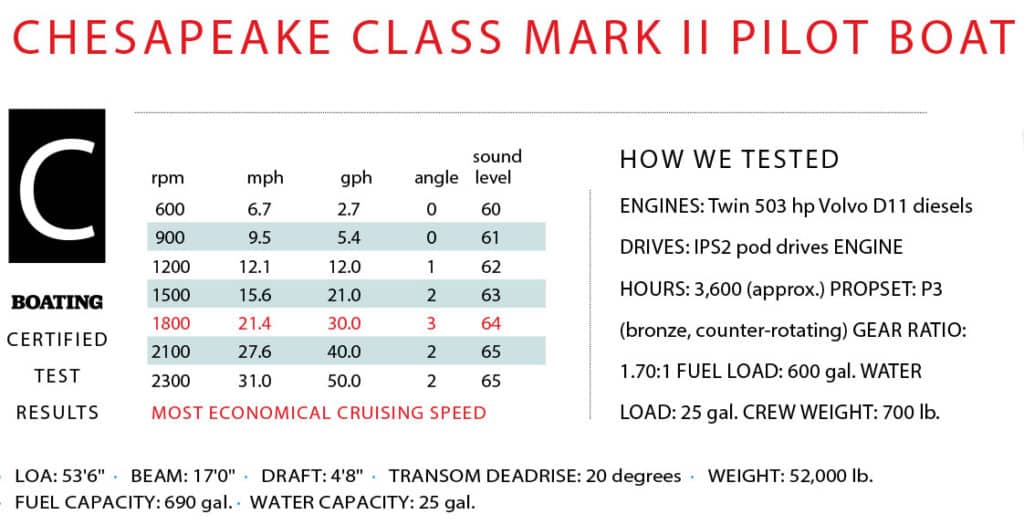
“We build a strong, stiff structural aluminum foundation around the rubber ring. The hull needs to be heavy enough to fit Hunt’s design specifications, so we put plenty of metal where it’s needed to make it strong,” Duclos reveals. “The guard areas (gunwales that contact the ship) get extra framing and aluminum plating inside, with a heavy rubber rail outside.”
In addition, used airplane tires hang along the entire length of the topside. (These tires are heavily built in the sidewalls but often suffer tread damage in takeoff and landing, so they’re an inexpensive source for sturdy fenders.)
Outside the pilothouse, the open, self-bailing deck offers a layout of handholds and railings that Gladding-Hearn designs, builds and installs in consultation with each client pilots association. (Boats in cold climates like Alaska get heated decks and handrails to prevent icing.)
Some associations specify boarding platforms set on pilothouse cabin tops. As noted earlier, Tampa Bay’s pilots use a short, deck-mounted staircase with railings for transfers. The stern decks of all pilot boats have pilot-rescue stations. Neither Jean nor Calbert has ever had a pilot fall overboard, but the Tampa boatmen run rescue drills every month, just in case.
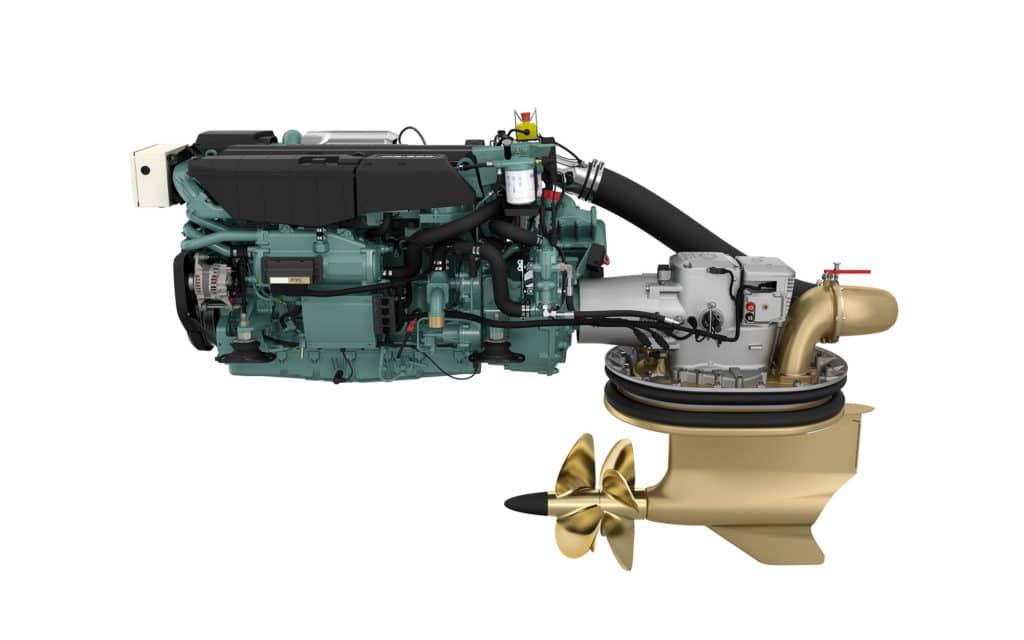
Working Wonders
Manatee has been such a success that Volvo Penta, Hunt Associates and Gladding-Hearn Shipbuilding have other Chesapeake Class Mark II pilot-boat projects in the works. For example, for the Virginia Pilot Boats Association, Duclos is adding 3 feet to the length, and using more powerful IPS D13-900 engines with IPS3 drives. The added size and speed benefit the longer run the Virginia pilots make out to the broad waters between the Virginia Capes at the mouth of the Chesapeake Bay.
In the end, “The results speak for themselves,” says Duclos. “We have developed great respect for Volvo. They are very thorough.”
“Maneuverability, speed and reliability are good with IPS,” adds Willard, “but they love the fuel savings.” In fact, the Tampa Bay Pilots Association is saving around 5,000 gallons of fuel each year with Manatee. And the drive systems are holding up well. When we took our ride aboard Manatee, it had been in service for 18 months, and its engine-hour meters showed 3,600. Even with its first-class regular maintenance program, the boat’s record of operation shows off its durability.
And the take-home lessons for us recreational boaters? Number one is the value of deeply thinking through the uses we plan for our boats. Number two is the value of boats produced by an integrated team such as Hunt Associates, Volvo Penta, Gladding-Hearn and Power Products. And the third is how well modern powerboats will hold up in service with regular use and careful maintenance. No, not everyone is ordering custom boats with seven-figure price tags, but we can be glad that the design-and-build systems developed for extreme duty like Manatee’s gradually extend to less-expensive models. Remember these lessons for your next purchase.

